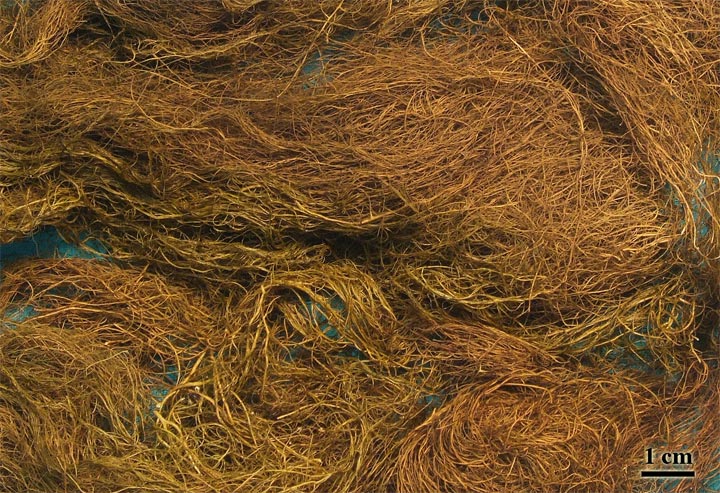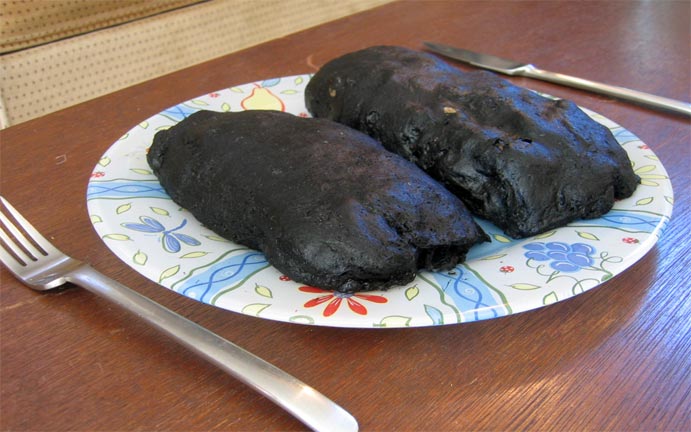Bryoria fremontii - Edible Horsehair Lichen (Wila)
Family: Parmeliaceae[1]
**Google Gemini** - Created with AI prompt (This page needs scrutiny)
1. Introduction to Bryoria fremontii
Bryoria fremontii is a distinctive dark brown, horsehair lichen, classified within the genus Bryoria and belonging to the Parmeliaceae family.[1] This genus encompasses approximately 23 other species in North America, many of which share similar appearances, making precise identification challenging.[1]
1.1. Classification and Nomenclature
Historically, Bryoria fremontii was sometimes referred to by the synonym Alectoria jubata.[5] More recent advancements in taxonomic research, particularly through the application of molecular data and DNA comparisons, have significantly refined its classification. These studies have conclusively demonstrated that Bryoria tortuosa, previously considered a separate species, is in fact conspecific with Bryoria fremontii.[2] This means they are now recognized as the same species, with observed variations between them attributed to differences influenced by their respective North American and European habitats.[2] Consequently, B. tortuosa has been formally synonymized with B. fremontii.[2]
1.2. Morphological Characteristics
Bryoria fremontii exhibits several key morphological features. Its main branches are notably thick, typically exceeding 0.4 mm in width, and often become flattened, twisted, and wrinkled in older specimens.[1] In contrast, most other Bryoria species possess narrower main branches.[1] B. fremontii is also unique in its remarkable length, regularly growing longer than 20 cm and occasionally reaching up to 90 cm.[1]
While generally dark brown, the lichen's color can vary, with some specimens exhibiting yellowish-brown or even bright yellow hues due to the presence of vulpinic acid.[1] Soredia (asexual reproductive structures) and apothecia (sexual reproductive structures) are uncommon. However, when present, they are highly distinctive due to their bright yellow coloration.[1] For practical identification, particularly concerning edibility, a more reliable characteristic for distinguishing poisonous specimens is the presence of abundant, long, yellow pseudocyphellae that twist around the main branches, visible with a hand lens.[1]
1.3. Habitat and Ecological Significance
Bryoria fremontii is an arboreal hair lichen, typically found hanging pendulously from trees, predominantly conifers, across western North America, northern Europe, and Asia.[1] It thrives in mountainous areas, commonly found at elevations between 1,200 and 2,300 meters in North America, though occasionally as low as 700 meters.[1] The lichen demonstrates a preference for drier forests with more open canopies. Within a forest, it is most abundant on trees and parts of trees that are less shaded, including dead or dying trees and older, defoliated branches.[1] Its abundance significantly increases with stand openness.[7]
Ecologically, B. fremontii holds substantial importance. It contains protein (2.5–5% dry weight) and lichenin (15–35% dry weight), a digestible carbohydrate for certain animals.[1] It serves as a vital food source for various ungulates and rodents, most notably the northern flying squirrel (Glaucomys sabrinus) and the woodland caribou (Rangifer tarandus caribou), particularly during winter.[1] The northern flying squirrel also uses this lichen for nest construction.[1] Hair lichens like Bryoria contribute to nutrient and water cycling and are indicators of forest ecosystem integrity.[8]
2. Geographic Distribution and Conservation Status
2.1. Global and Regional Distribution
Bryoria fremontii is widely distributed across western North America (Canada, USA, Mexico), northern Europe (Norway, Sweden, Finland, Russia), and Asia.[1][6] It has an estimated range exceeding 2,500,000 square kilometers with over 300 estimated occurrences globally.[6] Disjunct populations are recorded in Ontario, Manitoba, and Colorado.[6]
2.2. Environmental Conditions and Limiting Factors
Bryoria fremontii is an epiphyte on conifers and deciduous trees in open or shady forests.[6] It prefers drier forests with open canopies and less shaded conditions.[1][7] It benefits from rapid drying after rain and is intolerant of prolonged wetting.[7] Dark pigments (melanins) protect its algae from excess light and facilitate snowmelt for winter water and photosynthesis.[8]
2.3. Conservation Status and Threats
Globally, Bryoria fremontii is classified as "Least Concern" (LC) by the IUCN Red List.[5] NatureServe considers it "secure" globally.[6]
Potential threats include air pollution, logging, climate change, urban development, high-intensity wildfires, and fire suppression practices.[6] Regionally, it is presumed extirpated from the Sonoran Desert region since 1904.[6] Declines in related hair lichens in Fennoscandia are linked to pollution and forestry.[8]
3. Traditional Uses and Ethnobotanical Significance
Bryoria fremontii holds profound ethnobotanical significance, particularly among Indigenous peoples of North America.
3.1. Use as a Traditional Food Source
Known as "wila," Bryoria fremontii has been an important traditional food for several First Nations, including the Secwepemc, Shuswap, Nlaka'pamux, Lillooet, and Sinkaietk peoples.[1] It was traditionally pit-cooked with carbohydrate-rich foods (e.g., camas bulbs, saskatoonberries), allowing the lichen to absorb sugars and increase its carbohydrate content by 23% to 122%.[10] Harvesting involved twisting the lichen around a long stick ("txipmn" in Okanagan).[1] Cleaning ("kálka" in Secwepemc) involved hand-cleaning, soaking (often in running water), and sometimes pounding to remove debris and water-soluble toxic vulpinic acid.[1] Careful selection was crucial, as yellowish specimens or those with abundant yellow pseudocyphellae were considered poisonous.[1]
3.2. Traditional Medicinal Applications
Spanish New Mexicans used it for pyorrhea (rubbed on gums) and powdered it for sores/injuries.[11] Generally, lichens are used in traditional medicine for wounds, skin disorders, respiratory and digestive problems, and gynecological concerns, leveraging their secondary metabolites and carbohydrates.[12]
3.3. Other Cultural and Practical Uses
B. fremontii was used as a source of dye and fiber. The Lillooet used it with Alectoria sarmentosa for clothing (ponchos, footwear), sometimes interwoven with stronger fibers.[11] Its absorbent qualities were valued for wound dressings, diapers, sanitary napkins, and wiping salmon.[11] Interior Salish peoples used it mixed with mud for chinking log cabins.[11] In Okanagan tradition, it is believed to have originated from Coyote's hair braid.[11]
Table 1: Summary of Traditional Uses of Bryoria fremontii by Indigenous Groups
4. Phytochemistry and Pharmacology
4.1. Chemical Composition: Primary and Secondary Metabolites
Primary metabolites include protein (2.5–5% dry weight) and lichenin (15–35% dry weight).[1]
4.1.1. Vulpinic Acid: Presence, Toxicity, and Taxonomic Implications
Bryoria fremontii (and its conspecific B. tortuosa) are the only known Bryoria species to contain vulpinic acid, a toxic, bright yellow pulvinic acid derivative.[1][2] In some specimens, it's restricted to soralia and apothecia; in others (formerly B. tortuosa), it can be throughout the thallus.[2] Abundant, long, yellow pseudocyphellae indicate high vulpinic acid.[1] Its presence might be linked to a basidiomycete symbiont.[1] Traditional soaking may reduce vulpinic acid as it's slightly water-soluble.[1]
4.1.2. Other Identified Compounds
Traces of barbatolic and norstictic acid have been reported.[14] Lichens produce many secondary metabolites (depsides, depsidones, etc.), often up to 20% of thallus dry mass.[15][16]
4.2. General Biological Activities of Lichen Compounds
Lichen secondary metabolites exhibit various activities:[13][15]
- **Antimicrobial:** Antibacterial, antifungal, antiviral.
- **Anticancer/Antitumor:** Induce apoptosis; vulpinic acid (from *Letharia vulpina*) shows anticancer activity.
- **Antioxidant:** Attributed to phenolic compounds.
- **Anti-inflammatory and Analgesic.**
- **Enzyme Inhibition:** Against tyrosinase, xanthine oxidase, etc.
- **Other Activities:** Antipyretic, antiproliferative, cytotoxic, antidiabetic, photoprotective, etc.
Many lichen biosynthetic gene clusters are "silent," suggesting a vast unexplored chemical space.[15]
4.3. Specific Pharmacological Insights related to Bryoria fremontii
Bryoria fremontii contains toxic vulpinic acid.[1] However, vulpinic acid isolated from Letharia vulpina shows anticancer activity against various cell lines.[13] This highlights that a toxic raw compound can have therapeutic potential when purified and dosed correctly. Specific pharmacological studies on B. fremontii extracts are limited beyond vulpinic acid's general toxicity.[14]


